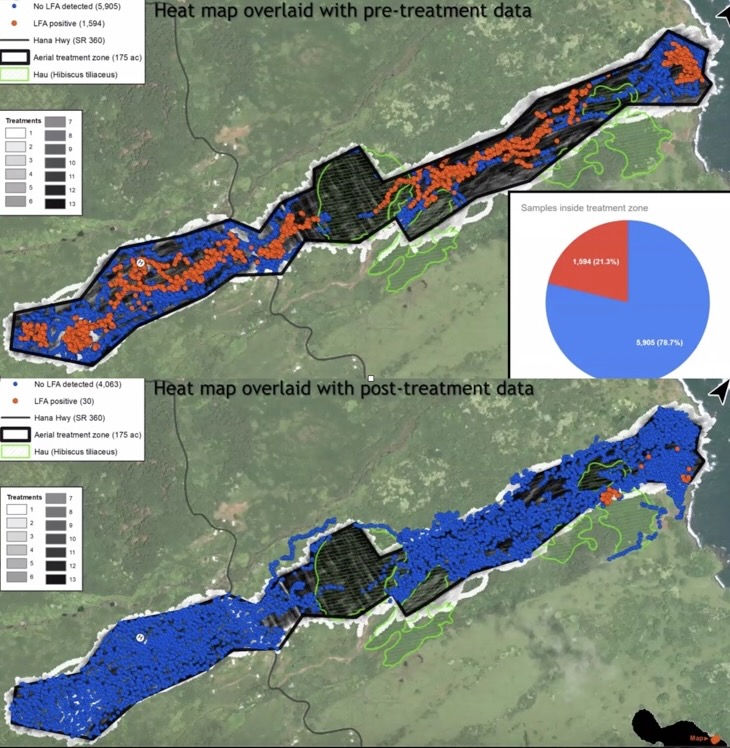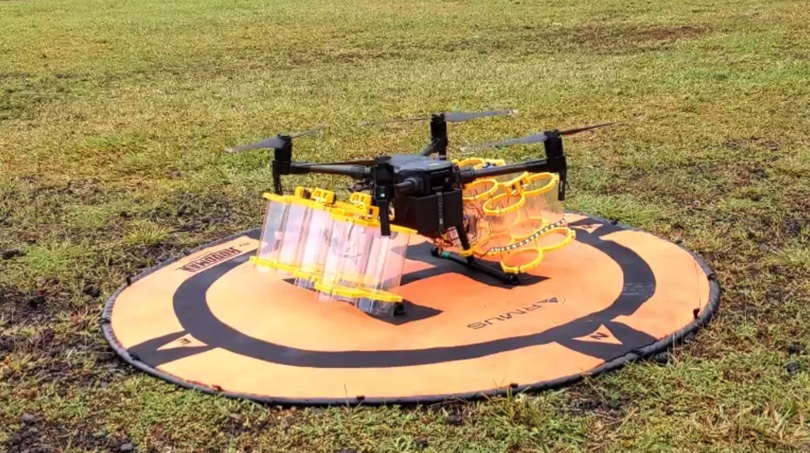Aerial Spraying Could Extinguish Little Fire Ant Infestations on Maui
“They’re miserable little things that we need to get rid of,” Brooke Mahnken of the Maui Invasive Species Committee said, referring to the little fire ant (Wasmannia auropunctata), which first invaded Maui in 2009.
The invasive ants’ stings can cause painful, itchy welts in humans and blindness in pets. The ants, originally from Central and South America, were first seen in Hawaiʻi in 1999 and are believed to have been inadvertently introduced to Hawaiʻi island years earlier.
“[T]he ants were present on nearly 40 acres by the time they were first detected,” according to stoptheant.org, a website dedicating to controlling the ant’s spread in Hawaiʻi.
On Hawaiʻi island, the ants are ubiquitous now. But on Maui, “Our goal is eradication,” said Mahnken, one of dozens of speakers at this year’s virtual Hawaiʻi Conservation Conference held in July.
There are currently 18 infestations on Maui and the state Department of Agriculture regularly intercepts the ants at Maui’s ports, he said. Seven are actively being treated, six others are being monitored, and five have been eradicated.
For one of the more difficult sites, a 175-acre incursion in Nāhiku, MISC has been working with the Hawai’i Ant Lab since 2019 on spraying via helicopter “using a gel bait matrix containing s-methoprene (brand name Altosid),” his abstract states.
The area contains large thickets of hau, which are “impossible to move through,” he said. The ants are believed to have been introduced at a home 800 feet above sea level and spread by stream all the way down to the ocean.
“We knew we needed to do something other than traditional ground work,” he said.
The ant lab, based on Hawaiʻi island, has a special needs permit that allows for the aerial treatments.
Using a custom-made “heli-squirter” the team disbursed the pesticide in 22-meter-wide swaths. Mahnken said the swaths were a bit haphazard and “not conducted in a uniform fashion.” But after 13 treatments over 19 months, MISC’s massive on-the-ground follow-up surveys offered signs of hope.
“It’s working,” Mahnken reported.
The team took four weeks to collect more than 7,000 samples from in and around the treatment area, crawling under hau, tromping though streams, and sliding down banks, he said.
Less than one percent of the samples had little fire ants and most of those positive samples were from just outside the treatment area, suggesting that there may have been an oversight in identifying the infestation boundary, or that the ants moved outside of it after treatment had begun, he said.

He noted that given the survey results, they have re-drawn the treatment zone. The new zone had six treatments between December 2021 and July 2022 and was scheduled to get one more last month.
Although the pesticide appeared to be effective in killing little fire ants as well as other species of ants found in the area, it doesn’t appear to be having non-target effects, Mahnken suggested.
“There is no shortage of mosquitoes out there. … Our treatment not only has been effective, it has been extremely targeted. We will continue this work until no ants are detected or we run out of funding,” he said. He added that Maui County has fully funded the project.
The Nāhiku methods could potentially be used to battle landscape-scale or intractable incursions elsewhere. The little fire ant has been detected on all of the inhabited Main Hawaiian Islands except Molokaʻi. Kauaʻi has had only two infestations, both on the north side of the island. One has been treated to undetectable levels and the other is actively being treated. On Lanaʻi, the ants were found in a single area with infested hapuʻu. No ants have been detected since it was treated.
Oʻahu, on the other hand, is grappling with two dozen sites that are undergoing boundary determination or treatment for the ants. The ants were eradicated from an additional seven sites.
Drones Used to Spread Waiwi Biocontrol Agent
Strawberry guava, native to Brazil, is also one of the worst invasive species to settle in Hawaiʻi. It forms nearly impenetrable stands that inhibit groundwater recharge and choke out native species. And as with the little fire ant, resource managers here hope to control the plant’s spread with assistance from the air.
At the Hawaiʻi Conservation Conference, University of Hawaiʻi at Hilo’s Ryan Perroy described efforts to drop branches with leaves infected with the biocontrol insect Tectococcus ovatus, also known as the Brazilian scale, onto strawberry guava forests on Hawaiʻi island and, ultimately, statewide.
The scale creates galls on the plant’s leaves, which “makes the plants a bit sick,” he said.
He said repeated drops would not be required, but to move up to an aerial dispersal system that covers an island or the entire state will require approval from the Federal Aviation Administration.
He said his lab has been waiting for years to get FAA certification to do what are considered “agricultural aircraft operations.”
“If you don’t have this certification, you’re really not supposed to be doing this type of aerial release, legally,” he said. His lab has secured a short-term authorization that allows it to work in smaller experimental areas.
To conduct the test, his team has mounted sections of PVC pipe to drones. The pipes hold canisters made of recycled water bottles that each contain a small guava branch infected with the scale. The canisters are controlled remotely to release the branches at a desired location.
So far, the lab has been able to load 16 canisters onto a single drone.

“Over larger areas, we really want to bring that to at least 64. … If we really want to scale up, we really need to go to helicopters,” he said, adding that drones are able to better control where the infected branches drop.
The Hawaiʻi Forest Industry Association has supported some trials earlier this year, which are going to be tested against human delivery, he said. At some point, helicopter trials are anticipated, then “monitoring, monitoring, monitoring.”
He noted that Timo Sullivan, drone program coordinator for Island Conservation, has developed high-imaging protocols to help identify leaf galls in treatment areas.
— Teresa Dawson

Leave a Reply